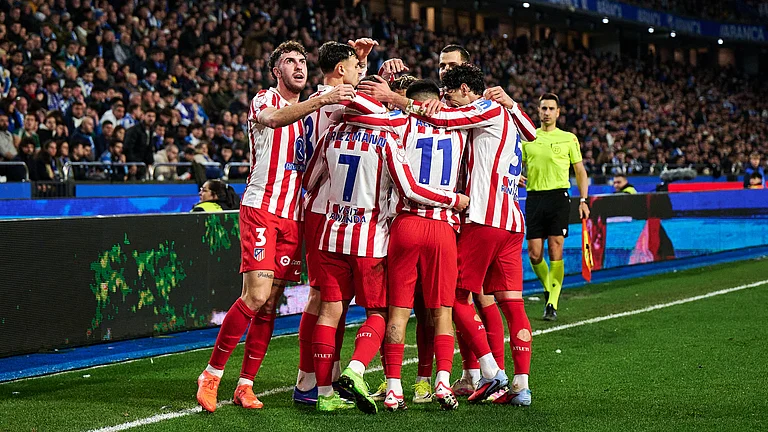In the run-up to the 2021 West Bengal Assembly elections, the Bharatiya Janata Party (BJP) released a music video of an election campaign song that recurrently used the name and photos of a Hindu gang-rape survivor from Bangladesh. The infamous incident happened in 2001 during a post-poll violence unleashed by the coalition of Bangladesh Nationalist Party (BNP) and Jamaat-e-Islami that had just won the election. After coming to power, Sheikh Hasina’s Awami League government tried to do what it could to stand by her. But for the Hindu nationalist camp in West Bengal, the incident was as relevant as ever.
The music video, which featured singer-turned-politician Babul Supriyo and several Bengali actors, also used images of security forces’ fight with visibly Muslim mobs and those of Islamic terror groups of West Asia, cautioning Hindus of West Bengal against taking ‘the Muslim problem’ lightly. It actually summed up their central electoral call—defeat Mamata Banerjee’s ‘Muslim-appeaser’ government to prevent West Bengal’s transformation into a mirror image of Muslim-majority Bangladesh.
Yet, they managed to win only one-fourth of the state’s 294 Assembly seats and polled fewer votes than they did in the 2019 Lok Sabha elections. Does it mean the people of Bengal rejected the overt Islamophobia spread by the Hindutva camp?
That would be an over-simplistic conclusion. The election also saw Suvendu Adhikari, who consistently referred to Banerjee as ‘Begum’, ‘Khala’, and ‘Phupu’—Arabic words for queen and aunts generally used by Muslims—and said that he did not need the votes of those who celebrated Pakistan’s victory in cricket, going on to defeat Banerjee from Nandigram Assembly seat.
Of all places, it was Nandigram, where the blowing of the conch shells blended with the prayers of the Azaan during the Banerjee-led anti-displacement movement in 2007-08. Adhikari, who was then one of her trusted lieutenants in the Nandigram battlefront, took to high-pitched Hindutva rhetoric soon after joining the BJP six months before the 2021 Assembly elections.
West Bengal, nationally known as a fortress of liberal socio-religio-cultural practices, did not fall to Hindu nationalists, but the advent of Hindutva in 2014 has evidently left the scars of Islamophobia widely visible.
In May this year, writer Sheikh Sahebul Haque pointed out in a Facebook post that in online media reports about the first, second, and third ranking students in the state board’s secondary exam, the comment section of a report naming Rifat Hassan Sardar as the second rank holder was full of Islamophobia—some accusing the government of helping a Muslim rank and some blasting the media for highlighting a Muslim’s achievement.
Being ruled by a politician who prefers to call herself a ‘rough and tough’ leader and vows to protect the minority communities from majoritarian aggression, West Bengal has not seen the kind of mob vigilantism associated with ‘cow protection’, ‘love jihad’ and selective anti-encroachment drives that some other parts of the country have witnessed. Nevertheless, this has not stopped Hindutva leader and supporters from referring to Muslims as ‘jihadi.’
“This is an outcome of a concerned Hindutva effort to create xenophobia,” says author and researcher Arnab Saha, an assistant professor of Bengali at Seth Anandram Jaipuria College in Kolkata, adding that the rise of the BJP at the national level in 2014 activated the latent Islamophobia of West Bengal’s Hindu society. “People are no longer ashamed or hesitant to publicly make Islamophobic comments. This wasn’t the case in post-Independence West Bengal, until 2013-14,” he says.
According to him, Hindu elites harboured anti-Muslim sentiments since the nineteenth century but it has percolated to other sections of the Hindu society, such as the middle castes and even lower castes. He sees it as part of the larger global phenomenon of the poor finding imaginary enemies to deal with the frustration and hopelessness of their daily lives.
“Hindus who have migrated from eastern Bengal in the face of anti-Hindu atrocities have genuine resentments against Muslims. However, for the other sections of the society, like the Kudmi-Mahatos and tribals of southwestern Bengal, who have had little to do with Muslims in their lives in the past, Muslims serve as the imaginary enemy to be blamed for all their misfortunes,” he says.
The Hindu nationalist brand of Islamophobia that thrives on the glorification of India’s pre-Islamic past and vilification of Muslim rule had its roots in colonial Bengal.
British East India Company’s employee John Z Holwell’s 1766 book Interesting Historical Events, relative to the Provinces of Bengal, and the Empire of Indostan, was among the sources that developed French Enlightenment philosopher Voltaire’s romanticisation of ancient India. If Voltaire’s 1773 work, Fragments sur l’Inde et sur le général Lalli, increased Western interest in ancient India, the Sanskrit-based Vedic civilisation to be precise, British philologist and East India Company administrator-turned-Supreme Court judge William Jones’ 1786 proposition that Sanskrit, Latin and Greek may have a common ancestry opened the floodgates.
Thousands of pages of literature highlight the greatness of ancient India over the following decades. India’s Muslim history found little space in these.

Kolkata being the centre of British activities in India, the English-educated Bengali Hindu elites, commonly referred to by the nomenclature of Bhadrolok, made up the first Indian society to be influenced by the writings of these European Indologists. This led to the development of Hindu nationalism around the mid-19th century when the Bhadrolok sought refuge in India’s West-acknowledged Hindu excellence. It appears to have been the necessary pride for countering the inferiority of a colonised people.
Anti-Muslim sentiments were reflected not only in the literary works of Hindu revivalists like Bankim Chandra Chattopadhyay, Rajnarain Bose and Chandranath Basu but also in the works of progressive-liberals like Jyotirindranath Tagore, Sarat Chandra Chattopadhyay, Abanindranath Tagore and even Rabindranath Tagore. Bankim and the three Tagores have all glorified Rajput, Sikh and Maratha valour against Muslim rulers. Rabindranath, though, shunned his anti-Muslim sentiments onwards 1906-07.
“Islamophobia or anti-Muslim sentiments existed among Bengali Hindu elites for several centuries and can be found in the 16th century Bengali literary work Chaitanya Charitamrita. However, it took a more overt shape in the second half of the 19th century, when the Bhadrolok emerged as Bengal’s dominant social force under colonial rule,” says Biswendu Nanda, who co-authored the recently-published book, Toder Tobari: Bhadrabitter Islamophobia Rajput Pousher Khonje (Todd’s Sword: Bhadrolok’s Islamophobia and their Search for Rajput Valour).
He says that Bengali society has traditionally accepted diversities and assimilation but there have been periods of communal hatred. The overt communal tension of the 1920s-1940s—leading to the Partition—became covert in West Bengal in the post-Independence period, subdued particularly by the rise of rights-based political movements by the Left parties. “For several decades after Independence, publicly expressing communal hatred was a taboo. The rise of the BJP in 2014 blew away that hesitation,” he says. Bengal’s larger history makes him hopeful that the current phase is going to pass and “Bengal would again settle for its inclusive nature.”
It is noteworthy that despite being among the hotbeds of communal strife during the 1920s-1940s and ravaged by the Partition on communal lines, political organisations with communal interests became almost irrelevant in post-Independence West Bengal. Neither the Bharatiya Jana Sangh, the predecessor of the BJP, nor the Hindu Mahasabha, nor Muslim political organisations like the Progressive Muslim League found footing.
Senior BJP-RSS ideologue Tathagata Roy, who served as governor of Tripura and Meghalaya, has repeatedly expressed his frustration that despite most of the post-Independence literary stalwarts of West Bengal having their ancestry in eastern Bengal, they never highlighted ‘the anti-Hindu nature of East Bengal Muslims.’
Things changed in 2014. It was in Bengal that Modi, the BJP’s prime ministerial candidate, first laid out the proposition that would much later be known as NRC-CAA, the twin citizenship screening/regularisation exercise based on discrimination between immigrants on the basis of religion.
“You (Banerjee) find people from Bihar and Odisha as alien but your face glows when the Bangladeshis come … as if your relatives from some seven generations have arrived!” Modi said while addressing a public meeting in Bengal in April 2014. A week later, he clarified that Bangladeshis who “love Bharat Mata and celebrate Durgashtami” were bona fide children of Bharat Mata deserving of equal status of every Indian citizen but the others—who were “pouring in due to vote bank politics” and “eating into the earnings of our youth”—must leave.
Since Modi’s swearing-in, the ‘Muslim problem’ has remained at the heart of Hindutva discourse in West Bengal, a state they claim was created in 1947 as a ‘homeland for Bengali Hindus’ and was now under threat from growing Islamic influence.
The increase in the Muslim share of West Bengal’s population— from 18 per cent in 1947 to 27 per cent in 2011—was one of the main proofs Hindu nationalists offered to convince Hindus of the imminent danger. However, the perception of Muslims as special beneficiaries of political-governmental benevolence did not find support in any recent socio-economic studies conducted in the state, including the reports of the Pratichi Trust founded by economy Nobel laureate Amartya Sen.
Political scientist Navine Murshid mentions in her recent book, India’s Bangladesh Problem The Marginalization of Bengali Muslims in Neoliberal Times, that she surveyed 41 firms in West Bengal in 2018 to gauge the degree to which ethnicity matters in employment, ranging from agricultural and industrial manufacturing to IT and banking. Only six of the forty-one firms mentioned they had Muslims among their high-skilled workers.
Overall, 90 per cent of high-skilled workers were male, Hindu, English-speaking, and from Kolkata, whereas low-skilled workers included equal proportions of men and women, and were predominantly rural and Muslim. “Even with a low response rate, the bifurcation was clear,” she wrote.
She concluded that upper-caste Hindu domination of the urban middle class continues in almost all aspects of political and cultural life, while “Bengali Muslims are almost nonexistent, except in their connection to Bangladesh.”
That, nevertheless, has not stopped anyone from creating paranoia around ‘impending Muslim superiority’ in the ‘designated homeland for Bengali Hindus.’
(This appeared in the print as 'Waves Of Violence')


























